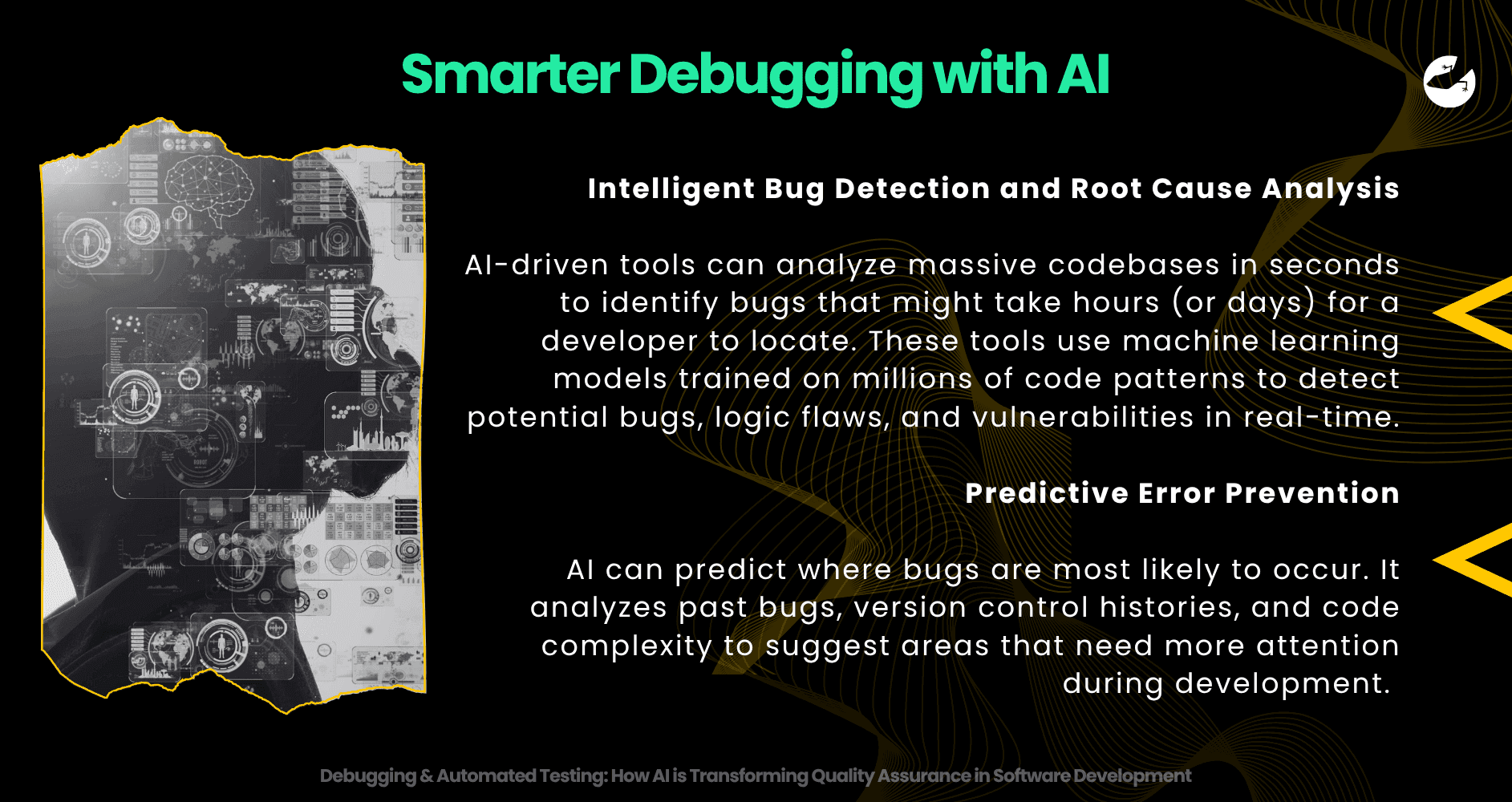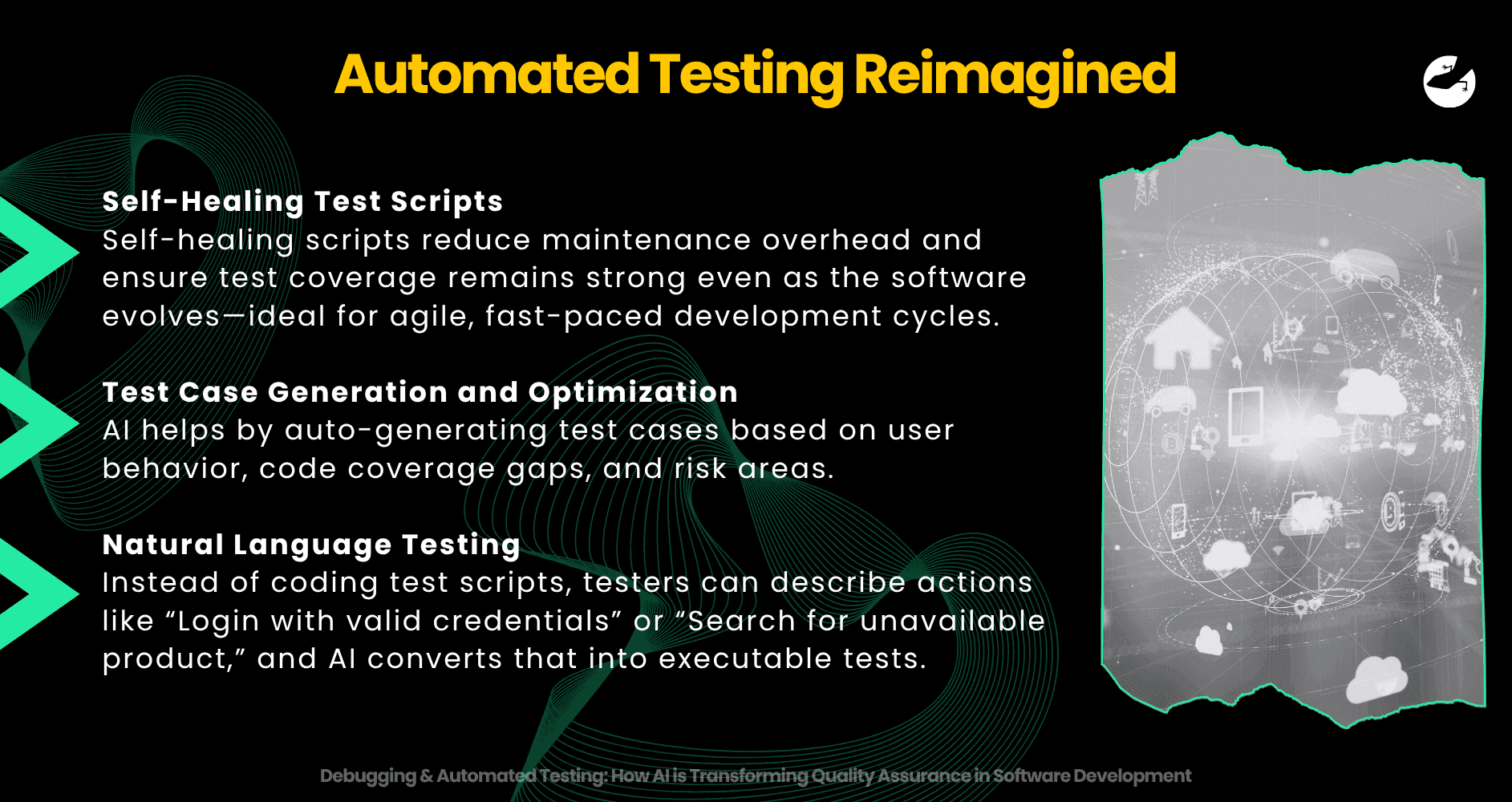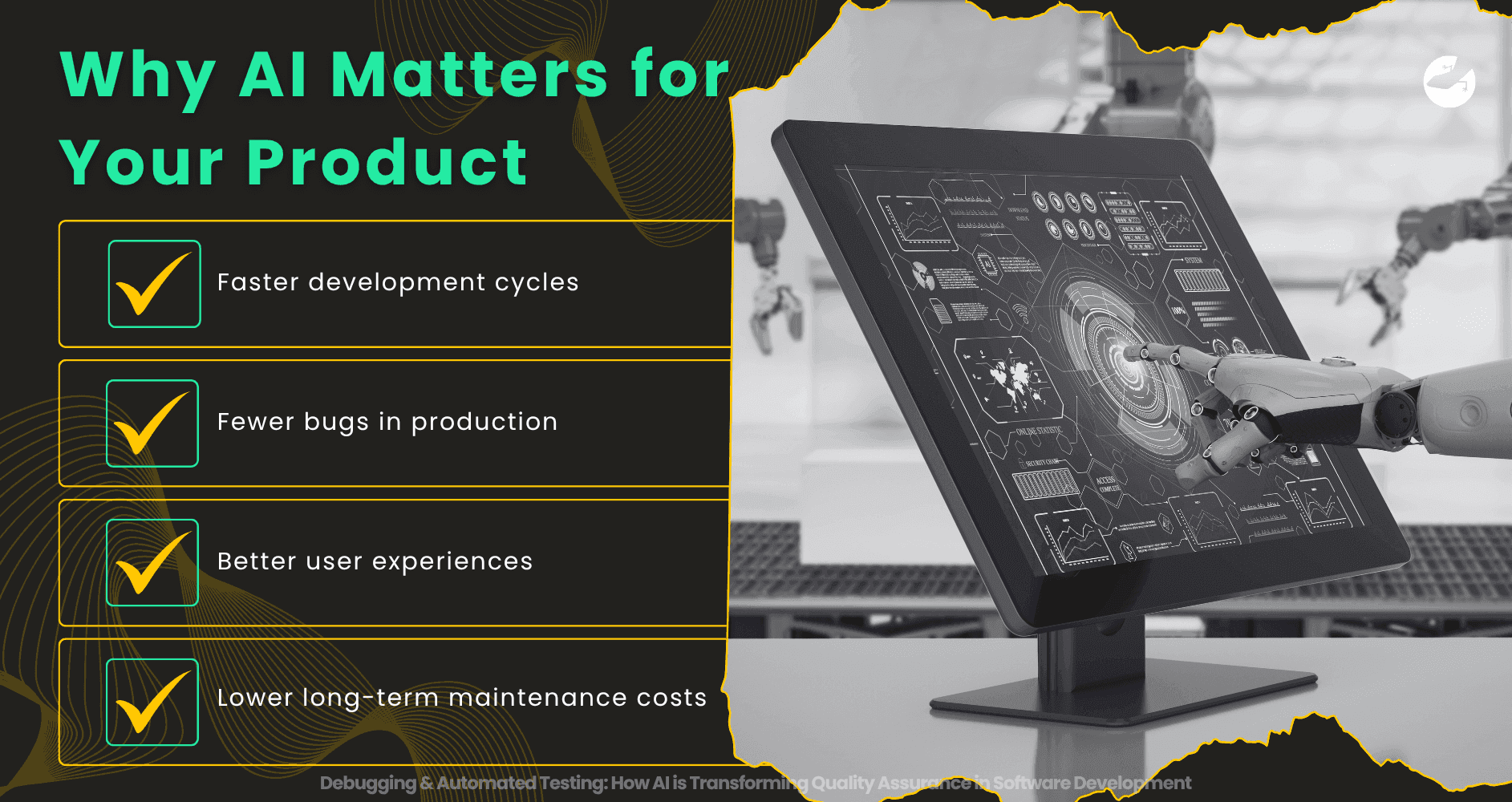Software Development
Artificial Intelligence
+ 5 more ...
Debugging & Automated Testing: How AI is Transforming Quality Assurance in Software Development

15 Jul 2025
by Nadiy, Senior Content Writer

15 Jul 2025
by Nadiy, Senior Content Writer
Software Development
Artificial Intelligence
Quality Assurance
Debugging
Automated Testing
Mobile App Development
Web App Development
Debugging & Automated Testing: How AI is Transforming Quality Assurance in Software Development
Table of contents
Contact us
We will get back to you in the next 48 hours.

Debugging & Automated Testing How AI is Transforming Quality Assurance in Software Development
Bugs are inevitable—but fixing them doesn’t have to be slow or painful. Explore how AI is reshaping the way software teams handle debugging and automated testing, helping you build faster, smarter, and more reliable digital products.
key takeaways
, and drain resources faster than you can trace. But here’s the game-changer: AI isn’t just helping developers catch bugs—it’s helping prevent them. The landscape of quality assurance (QA) in software development is evolving rapidly, and artificial intelligence is at the center of it.
From writing test cases to detecting edge-case errors before a human ever sees them, AI is redefining how software gets built, tested, and shipped. If you’re a product owner, developer, or tech leader looking to deliver scalable, high-quality digital products faster, this blog unpacks how AI-powered debugging and automated testing are making that possible.
The Traditional QA Bottleneck
Quality assurance has always been vital—but it’s also been one of the most time-consuming phases of software development. Manual testing, repetitive debugging cycles, and late-stage defect detection often led to delays, ballooning costs, and frustrated teams.
, QA processes still required ongoing human oversight, frequent maintenance, and rigid scripting.
But AI is flipping the script by making QA smarter, faster, and more intuitive.
Smarter Debugging with AI

1. Intelligent Bug Detection and Root Cause Analysis
AI-driven tools can analyze massive codebases in seconds to identify bugs that might take hours (or days) for a developer to locate. These tools use machine learning models trained on millions of code patterns to detect potential bugs, logic flaws, and vulnerabilities in real-time.
Instead of just highlighting the existence of an error, AI can help trace its root cause. That means less time reading error logs and more time building features that matter.
2. Predictive Error Prevention
Beyond just fixing errors, AI can actually predict where bugs are most likely to occur. It analyzes past bugs, version control histories, and code complexity to suggest areas that need more attention during development.
This kind of predictive QA helps teams write cleaner code from the outset and avoid issues before they appear in production.
Automated Testing Reimagined

1. Self-Healing Test Scripts
Traditional automated test scripts
are brittle—small UI or logic changes can break them, leading to false positives and wasted debugging time. AI-powered testing frameworks can recognize these changes and adapt in real-time.
These self-healing scripts reduce maintenance overhead and ensure test coverage remains strong even as the software evolves—ideal for agile, fast-paced development cycles.
2. Test Case Generation and Optimization
Writing comprehensive test cases manually can be tedious. AI helps by auto-generating test cases based on user behavior, code coverage gaps, and risk areas.
It can also prioritize test scenarios that are most likely to fail or have a high impact, helping QA teams focus their efforts where it matters most.
3. Natural Language Testing
Some AI tools allow QA teams to write test scenarios in natural language. Instead of coding test scripts, testers can describe actions like “Login with valid credentials” or “Search for unavailable product,” and AI converts that into executable tests.
This lowers the barrier for non-technical team members and boosts cross-functional collaboration.
Want to find out how much it costs to build your dream app or web app?
AI in CI/CD Pipelines: Quality at Speed
Continuous Integration and Continuous Deployment (CI/CD)
pipelines are only as strong as their QA processes. AI ensures that testing doesn’t become the bottleneck in a DevOps workflow.
By integrating with CI/CD, AI tools can automatically trigger smart tests, assess release risks, and flag regressions before code hits production. This enables faster, safer releases—essential for modern software teams.
Is AI Replacing QA Teams?
Not at all. AI isn’t about replacing testers—it’s about empowering them. With AI handling repetitive, data-intensive tasks, QA professionals can focus on more strategic activities like exploratory testing, usability evaluation, and test planning.
It’s a shift from reactive to proactive quality assurance—one that blends the best of human insight and machine efficiency.
Why This Matters for Your Product

High-quality software isn't optional—it’s expected. AI-enabled debugging and testing mean:
- Faster development cycles
- Fewer bugs in production
- Better user experiences
- Lower long-term maintenance costs
And that’s a competitive edge in today’s fast-moving tech landscape.
How Lizard Global Can Help
At Lizard Global, we believe that quality assurance isn’t just a final step—it’s baked into every part of the development process. Our approach combines AI-powered tools with hands-on expertise to deliver reliable, scalable, and beautifully built software.
Whether you're launching a mobile app, rebuilding your backend architecture, or scaling an existing platform, we integrate intelligent debugging, automated testing, and continuous QA into every stage of development.
Let’s build smarter software—together.
Ready to ship software that works from day one? Get in touch with the team at Lizard Global and let’s talk quality.
Join 2000+ subscribers
Stay in the loop with everything you need to know

Debugging & Automated Testing How AI is Transforming Quality Assurance in Software Development
Bugs are inevitable—but fixing them doesn’t have to be slow or painful. Explore how AI is reshaping the way software teams handle debugging and automated testing, helping you build faster, smarter, and more reliable digital products.
, and drain resources faster than you can trace. But here’s the game-changer: AI isn’t just helping developers catch bugs—it’s helping prevent them. The landscape of quality assurance (QA) in software development is evolving rapidly, and artificial intelligence is at the center of it.
From writing test cases to detecting edge-case errors before a human ever sees them, AI is redefining how software gets built, tested, and shipped. If you’re a product owner, developer, or tech leader looking to deliver scalable, high-quality digital products faster, this blog unpacks how AI-powered debugging and automated testing are making that possible.
The Traditional QA Bottleneck
Quality assurance has always been vital—but it’s also been one of the most time-consuming phases of software development. Manual testing, repetitive debugging cycles, and late-stage defect detection often led to delays, ballooning costs, and frustrated teams.
, QA processes still required ongoing human oversight, frequent maintenance, and rigid scripting.
But AI is flipping the script by making QA smarter, faster, and more intuitive.
Smarter Debugging with AI

1. Intelligent Bug Detection and Root Cause Analysis
AI-driven tools can analyze massive codebases in seconds to identify bugs that might take hours (or days) for a developer to locate. These tools use machine learning models trained on millions of code patterns to detect potential bugs, logic flaws, and vulnerabilities in real-time.
Instead of just highlighting the existence of an error, AI can help trace its root cause. That means less time reading error logs and more time building features that matter.
2. Predictive Error Prevention
Beyond just fixing errors, AI can actually predict where bugs are most likely to occur. It analyzes past bugs, version control histories, and code complexity to suggest areas that need more attention during development.
This kind of predictive QA helps teams write cleaner code from the outset and avoid issues before they appear in production.
Automated Testing Reimagined

1. Self-Healing Test Scripts
Traditional automated test scripts
are brittle—small UI or logic changes can break them, leading to false positives and wasted debugging time. AI-powered testing frameworks can recognize these changes and adapt in real-time.
These self-healing scripts reduce maintenance overhead and ensure test coverage remains strong even as the software evolves—ideal for agile, fast-paced development cycles.
2. Test Case Generation and Optimization
Writing comprehensive test cases manually can be tedious. AI helps by auto-generating test cases based on user behavior, code coverage gaps, and risk areas.
It can also prioritize test scenarios that are most likely to fail or have a high impact, helping QA teams focus their efforts where it matters most.
3. Natural Language Testing
Some AI tools allow QA teams to write test scenarios in natural language. Instead of coding test scripts, testers can describe actions like “Login with valid credentials” or “Search for unavailable product,” and AI converts that into executable tests.
This lowers the barrier for non-technical team members and boosts cross-functional collaboration.
Want to find out how much it costs to build your dream app or web app?
AI in CI/CD Pipelines: Quality at Speed
Continuous Integration and Continuous Deployment (CI/CD)
pipelines are only as strong as their QA processes. AI ensures that testing doesn’t become the bottleneck in a DevOps workflow.
By integrating with CI/CD, AI tools can automatically trigger smart tests, assess release risks, and flag regressions before code hits production. This enables faster, safer releases—essential for modern software teams.
Is AI Replacing QA Teams?
Not at all. AI isn’t about replacing testers—it’s about empowering them. With AI handling repetitive, data-intensive tasks, QA professionals can focus on more strategic activities like exploratory testing, usability evaluation, and test planning.
It’s a shift from reactive to proactive quality assurance—one that blends the best of human insight and machine efficiency.
Why This Matters for Your Product

High-quality software isn't optional—it’s expected. AI-enabled debugging and testing mean:
- Faster development cycles
- Fewer bugs in production
- Better user experiences
- Lower long-term maintenance costs
And that’s a competitive edge in today’s fast-moving tech landscape.
How Lizard Global Can Help
At Lizard Global, we believe that quality assurance isn’t just a final step—it’s baked into every part of the development process. Our approach combines AI-powered tools with hands-on expertise to deliver reliable, scalable, and beautifully built software.
Whether you're launching a mobile app, rebuilding your backend architecture, or scaling an existing platform, we integrate intelligent debugging, automated testing, and continuous QA into every stage of development.
Let’s build smarter software—together.
Ready to ship software that works from day one? Get in touch with the team at Lizard Global and let’s talk quality.
Join 2000+ subscribers
Stay in the loop with everything you need to know
FAQs

What is AI-powered debugging?
How does AI improve automated testing?
What are self-healing test scripts?
Can AI detect bugs before they happen?
Is AI replacing QA engineers?
How does AI support CI/CD pipelines?
What are the benefits of using AI in quality assurance?
Which tools are commonly used for AI-powered testing?
similar reads







